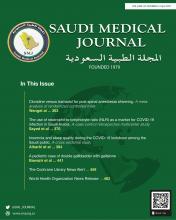Abstract
Clinical Presentation A 2-month-old baby boy, of full-term spontaneous vaginal delivery, presented to the dermatology outpatient clinic with generalized erythroderma, which had been noted since birth. Family history was positive for similar disease in his eldest sister, who died at 6 months of age without a diagnosis. On examination, the patient looked ill with generalized erythroderma, yet there were no signs of ectropion, eclabium, or deformed ears. Diffuse scalp scaling was observed with interlocking tessellation scales over the scalp (Figure 1). Hair microscopy showed in Figure 2. All laboratory results were normal.
Question
1. What is the diagnosis?
2. What is the etiology of this condition?
3. What are the characteristic clinical features of the condition?
Answer
1. Netherton syndrome (NS) (OMIM 256500) is affecting the immune systems and skin appendages including atopic dermatitis, retardation of growth and death early on life.1 It frequently presents as neonatal erythroderma, in which early neonatal diagnosis of NS has always been challenging.1
2. Comel NS is caused by SPINK5 serine peptidase inhibitor Kazal-type 5 gene (mutations encoding a serine protease inhibitor).2
3. Ichthyosis, in the form of tram like ichthyosis, bamboo like hair and atopic diathesis constitute the triad of NS. The finding of trichorrhexis invaginata (TI), also known as bamboo hair, is pathognomonic for NS, but may not be easily seen in neonates and young infants. Netherton syndrome frequently presents as a neonatal erythroderma, in which early diagnosis of NS is challenging. Here we describe a new physical sign of interlocking tessellated scales over the scalp, highly suggestive of NS; we believe this sign can help with early diagnosis.2
- Prominent interlocking tessellated scales over the scalp, resembling roof tiles, in a neonate with Netherton syndrome.
- Hair microscopy showing Trichorrhexis invaginata.
Discussion
Netherton syndrome was first reported by Comel and Netherton in 1958.2 As stated, it is uncommon disease with ichthyosis, presenting like ichthyosis linearis circumflexa (ILC), TI, and atopic dermatitis.2 Neonates with NS usually present with full body congenital erythema or rarely as a collodion membrane. Early childhood, skin manifestations gradually expressed into diagnostic ILC, with tram like plaques and pathognomonic 2-edged scales.3 The finding of TI is pathognomonic for NS. Enteropathy, failure to thrive, hypoalbuminemia, and temperature instability have also been reported.1
Netherton syndrome is autosomal recessive that affect both male and female equally.2 The gene defect has recently been identified as a serine protease inhibitor.4 This leads to reduction of the enzyme activity in the skin.
Early diagnosis of neonatal NS has consistently been challenging. Congenital neonatal erythroderma has wide differential diagnoses. Many suggestions were offered to improve diagnostic accuracy of neonatal and infantile NS, including multiple samples from the scalp and eyebrow hairs, while looking for TI. The interlocking tessellation scales on the scalp, resembling roof tiles, is highly suggestive of NS, which could be a fairly specific sign: the exact pathogenesis for this sign is unclear, but deserves further investigation. These overlapping and interlocking scalp scales could be a miniature form of ILC in newborn skin over the scalp.
In conclusion, we found the roof tiles sign to be useful in the early diagnosis of NS, which is essential to mitigate the high mortality rate in neonates and infants with it.
Withdrawal policy
By submission, the author grants the journal right of first publication. Therefore, the journal discourages unethical withdrawal of manuscript from the publication process after peer review. The corresponding author should send a formal request signed by all co-authors stating the reason for withdrawing the manuscript. Withdrawal of manuscript is only considered valid when the editor accepts, or approves the reason to withdraw the manuscript from publication. Subsequently, the author must receive a confirmation from the editorial office. Only at that stage, authors are free to submit the manuscript elsewhere.
No response from the authors to all journal communication after review and acceptance is also considered unethical withdrawal. Withdrawn manuscripts noted to have already been submitted or published in another journal will be subjected to sanctions in accordance with the journal policy. The journal will take disciplinary measures for unacceptable withdrawal of manuscripts. An embargo of 5 years will be enforced for the author and their co-authors, and their institute will be notified of this action.
- Copyright: © Saudi Medical Journal
This is an open-access article distributed under the terms of the Creative Commons Attribution-Noncommercial License (CC BY-NC), which permits unrestricted use, distribution, and reproduction in any medium, provided the original work is properly cited.








